
The shoulders of the human body undergo tremendous strain over time. Arm and back movements take a toll on the shoulders. People who have manual labor jobs, athletes, and people who must complete repetitive manual tasks with their arms may experience several different types of shoulder injuries. These injuries may include acute injuries such as rotator cuff tears or degenerative injuries like arthritis that worsen over time.
For years, typical treatments for shoulder injuries included lifestyle changes, stretches, pain medications, or surgery for extreme cases.
Today, advancements in stem cell therapy offer many people struggling with common shoulder injuries more complete healing without the invasive side effects of surgery.
The bones of the upper arm and shoulder joint form a ball and socket connection. These bones have cartilage between them that prevents the bones from rubbing against one another as the shoulder joint moves. Over time, this cartilage may deteriorate, causing pain when moving the arms or chronic pain that simply never goes away.
Shoulder arthritis can be incredibly debilitating, preventing the full use of the arms and back, inhibiting sleep due to pain, and limiting range of motion. In extreme cases, the standard treatment is shoulder replacement surgery, in which the patient’s deteriorating shoulder joint is surgically removed and replaced with an artificial joint. While this may prove effective for some individuals, shoulder replacement is a very invasive procedure that involves significant recovery time; there is no guarantee the artificial joint will last for the rest of the person’s life.
Stem cell therapy for shoulder arthritis entails a stem cell shoulder injection of the patient’s own stem cells into the target shoulder. The team performing the procedure extracts the patient’s stem cells from their own bone marrow and then injects the cells into the shoulder joint. Stem cells are unique in that they can transform into many different types of cells. In this case, the stem cells would gradually become new cartilage cells in the shoulder, preventing the bones in the shoulder joint from painfully rubbing together.
The rotator cuff is the mass of muscles and ligaments surrounding the bones of the shoulder joint. A rotator cuff injury may occur from repetitive physical activity, such as lifting or carrying heavy items, or an acute injury from playing sports or an accident. Some rotator cuff injuries develop slowly over time, gradually limiting the victim’s range of motion and increasing pain.
In most cases, the standard treatments for rotator cuff injuries include rest, lifestyle changes, topical pain medications, hot and cold compresses, or surgery for extreme tears. However, stem cell therapy could be a less invasive and more effective alternative treatment for some patients suffering from rotator cuff injuries.
Stem cell therapy could be a highly effective alternative treatment for many shoulder injuries, but it helps to understand what risks the stem cell procedure entails, what to expect during a stem cell therapy session, and what kind of results you should hope to see. Most patients who undergo stem cell therapy for shoulder injuries recover from the procedure within a week or even two. After four to six weeks, patients generally report reduced pain, increased range of motion, and significant relief from their shoulder injury symptoms. The stem cells injected continue to last and will continue working in the target area for up to one year following the procedure, and the relief patients experience generally improves during this time.
To reserve your seat at our informative seminar, fill out the form below or call (508) 231-5700. When you attend, you’ll find out if stem cell therapy is right for you.
By providing us with your information you are consenting to the collection and use of your information in accordance with our Terms of Service and Privacy Policy.
IMPORTANT! This information is for educational purposes only and is NOT intended to replace the care or advice given by your physician. Boston Applied Biologics is not offering regenerative cell therapy or other regenerative therapies as a cure for any condition, disease, or injury. No statements or implied treatments on this website have been evaluated or approved by the FDA. This website contains no medical advice. All statements and opinions provided by this website are provided for educational and informational purposes only and we do not diagnose or treat via this website or via telephone. We do not claim that any applications, or potential applications, using autologous regenerative cells and other regenerative cells are approved by the FDA, or are even effective. We do not claim that these treatments work for any listed nor unlisted condition, intended or implied. Always seek the advice of your physician or other qualified health provider before starting any new treatment or with any questions you may have regarding a medical condition. For more information see our Medical Disclaimer.
Copyright © 2025 Boston Applied Biologics, LLC. All Rights Reserved.

How Orthobiologic Therapy can relieve your joint, muscle and tendon pain without surgery so that you can get back to enjoying your life*
We are committed to your privacy. Boston Applied Biologics uses the information you provide us to contact you about relevant content, products, and services. By providing us with your information you are consenting to the collection and use of your information in accordance with our Terms of Service and Privacy Policy. You may unsubscribe from these communications at any time.